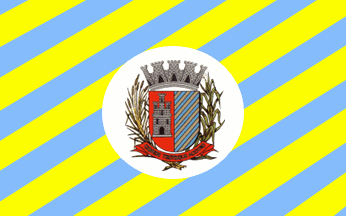 image by
Dirk Schönberger,
11 February 2013
image by
Dirk Schönberger,
11 February 2013Based on: http://pt.wikipedia.org/wiki/Sete_Barras

Last modified: 2013-02-25 by ian macdonald
Keywords: sao paulo | sete barras |
Links: FOTW homepage |
search |
disclaimer and copyright |
write us |
mirrors
 image by
Dirk Schönberger,
11 February 2013
image by
Dirk Schönberger,
11 February 2013
Based on:
http://pt.wikipedia.org/wiki/Sete_Barras
Diagonally striped yellow and blue with the municipal arms in the centre on a white disk.
Official website at
http://www.setebarras.sp.gov.br
Dirk Schönberger,
11 February 2013
Sete Barras ("Seven Bars") is named for a local legend related by Diogo Martins Ribeiro Júnior in "Riquezas da Ribeira de Iguape" (1922). A Spanish gold scavenger once found many nuggets, which were transformed in seven heavy bars. Before coming back to Spain with his bounty, the Spanish had to stop at the gold registration office, to pay a 5%-tax to the Portuguese Crown. He buried the gold in Goyntahogoa and went to Juquiá, where Indians explained him how to reach the port of Santos without paying the tax. An Indian told him that there was much more gold to collect in a place called Tarenconcé; accordingly, the Spanish postponed his leave and went to Tarenconcé, where he easily collected gold. After a few other exploration campaigns, he went back to Goyntahogoa; after two days of unsuccessful search for the location of the buried gold, the Spanish returned home with the gold collected in Tarenconcé, which was, unfortunately, in lower amount and quality. The treasure is still to be found and Goyntahogoa was renamed Sete Barras.
The district of Sete Barras was established by Provincial Law No. 58 of 23 March 1885, as part of the municipality of Xiririca. The Japanese colonization of the region was initiated on 12 August 1920 by the "Kaigai Kogio Kabushiki Kaisha" (KKKK) company, which also extracted gold form the Cavalo Magro mine, today owned by the São Paulo State bank. After the Second World War, Sete Barras turned in a main area of cultivation of banana; the nickname of "Green Gold of the Valley" was adopted by Municipal Law No. 429 of 28 November 1975. In 1944, Sete Barras was transferred to the newly formed municipality of Registro. The municipality of Siete Barras was established by State Law No. 5,521 of 18 December 1958.
The flag of Sete Barras is blue with seven yellow diagonal stripes (per bend sinister). In the middle is placed the municipal coat of arms, inscribed in a white disk. The dimensions of the flag are 14 units x 20 units. The width of the stripes is 1.5 unit. The diameter of the white disk is 9 units. The height of the coat of arms is 7 units.
http://www.setebarras.sp.gov.br/novo_site/index.php?exibir=secoes&IDNOTICIA=4&ID=51 - Municipal website
Photos of the flag
http://www.ovaledoribeira.com.br/2012/06/imagem-peregrina-de-nossa-senhora.html
http://www.ovaledoribeira.com.br/2011/12/prefeita-de-sete-barras-participa-de.html
http://www.samuelmoreira.com.br/meu-dia-a-dia/em-sete-barras-deputado-volta-a-defender-reforma-politica
The coat of arms of Sete Barras, designed by Lauro Ribeiro Escolar, is prescribed by Municipal Law No. 392 of 10 July 1974. "Rounded-off shield, per pale, 1. Gules a castle argent masoned sable ports and windows of the same, 2. Azure seven bend sinister or. The shield surmounted by an eight-towered mural crown argent ports sable. The shield supported dexter by a bunch of rice plants and sinister by a plant of maize the tow leaved and fructed proper. Beneath the shield a scroll gules inscribed with the motto 'CORDE TECTOQUE ACCIPIO' in letters argent."
The rounded-off, or Iberic, shield, used in Portugal at the time of discovery of Brazil, is a tribute to the first colonizers and builders of the country. Gules is a symbol of audacity, valour, courage, valiance, nobleness, triumph and honour, recalling the courage of the first colonizers of the region. The castle is a symbol of greatness, safeguard, magnanimity, shelter, support, protection and safety, recalling that Sete Barras originates in the building of an inn where the early builders could find shelter against harsh weather and the dangers of the forest. Argent is a symbol of felicity, purity, candour, frankness, truth, honesty, friendship and integrity. Azure is a symbol of justice, beauty, sweetness, nobleness, recreation, vigilance, serenity, constancy, incorruptible firmness, dignity, zeal and loyalty. The seven ("sete") bends ("barras") recall the legend at the origin of the name of the place, where adventurers found gold. Or is a symbol of wealth, splendour, glory, nobleness, power, force, faith, prosperity, sovereignty and rule. The mural crown is a symbol of municipal emancipation. The open ports are a symbol of hospitality. The rice and maize plants emphasize the fertility of the generous soil, being important crops that contribute to the growth of the municipality, of the State and of Brazil.
http://www.setebarras.sp.gov.br/novo_site/index.php?exibir=secoes&IDNOTICIA=4&ID=51 - Municipal website
Ivan Sache, 14 February 2013